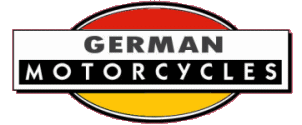

A Brief History
The Metallwerke Frankenberg /Sachsen Company was formed by Rassmussen, founder of DKW, in 1923 to produce components for DKW. These parts, particularly the saddles, proved popular with other manufacturers.
The first three-wheeler commercial vehicle was manufactured in 1924 under the DKW marque. Advertised as the DKW-Transportwagen it had a flat tray supported by two wheels at the front and was otherwise very similar to the Lomos.
The catalogue soon thickened. 1926 saw the addition of the DKW Type TV with a 300cc DKW engine mounted above the front wheel, with two seats and a large goods cabin supported by two rear wheels. The roof of the cabin extended forward of the driver's seat to offer protection against the elements. It had a highly distinctive exhaust mounted on the left side of the front fork.
Shortly thereafter it was renamed the DGW, and then the name Framo was adopted - derived from the company's name, Frankenberg Metalwerke.
The Framo LT300 of 1930 was similar to the TV, but had a fully enclosed driver compartment built from plywood. It retained the tiller steering of the TV, and the engine remained fully exposed. This was followed in 1933 by the LTH300 with an enclosed engine bay.
That year the army re-occupied the barracks Framo operated from and they moved to Hainichen and in 1934 they changed the company name to Framo-Werke GmbH. In those two years three-wheeler automobiles and four-wheel delivery vans were added to the range.
When DKW, Audi, Wanderer and Horch formed Auto Union, Framo received an additional boost, since all parts-delivery and service vehicles for the various Auto Union dealerships bore the Framo name.
Rassmussen was a keen proponent of small two-stroke powered cars and had a yen to build his own. A prototype design was available from an engineer by the name of Neimann, of Cologne. This diminutive three-wheeler was powered by a 500cc DKW two-stroke twin driving the front wheels. Rasmussen bought the patent rights for the vehicle and introduced a variety of ideas, the end result of which was the Framo Stromer.
Four different versions were planned with engines of 200, 300, 400 and a 600cc, but the only model built had a DKW 200cc single cylinder 2-stroke engine, making it tax- and drivers license free - to obtain a full-blown drivers license in Germany at the time was not inexpensive, making this an attractive proposition for the market.
The 200cc power plant delivered a cruising speed of 40 mph, fully loaded with two adults and luggage. It had a four-speed gearbox.
In order to penetrate the market, Framo decided to demonstrate the reliability of their little car by establishing well-publicized record runs on the world famous Avus race track in Berlin.
Between May 25 and June 6 1933 a Framo Stromer covered some 14,000 kilometers without incident, stopping only to change drivers and refuel. No repairs were required, not even a change of sparkplug - this in the days when every rider, particularly those of two-strokes, carried spare plugs as plug fouling was so common.
To reinforce their documented proof of reliability, they drove the same car from Berlin to London and back, again without a single problem. These were remarkable feats for the times.
The tiny automobile, despite its good looks and winning ways, did not fare well commercially.
Their final attempt to crack the market was the four-seater, four-wheeled Framo Picollo, with a single door on the right side. The body was marine ply covered with vinyl, and it had sliding safety-glass windows. Powered by a 300cc DKW motorcycle engine, the first model was front wheel drive, with later models adopting the more conventional rear-engine rear-wheel drive configuration.
Despite all this, the Picollo did not achieve good market penetration. It was manufactured until 1938.
Sales of Framo three-wheeled delivery vans continued unabated throughout the 1930s until 1938 when the corrupt Nazi government awarded exclusive rights to build such vehicles to their chief competitors, Goliath and Tempo. Framo was restricted to building conventional four-wheel commercial trucks, albeit small ones. These were produced until 1943, after which their output was mostly replacement parts and components for the Wehrmacht.
Postwar, the company came under Soviet control. Production resumed in 1949 under the Framo name before being changed to VEB Barkas. Thanks, Adolf.
Sources: dkwautounionproject.blogspot.com, et al.
If you have a query or information about Framo machines, please contact us